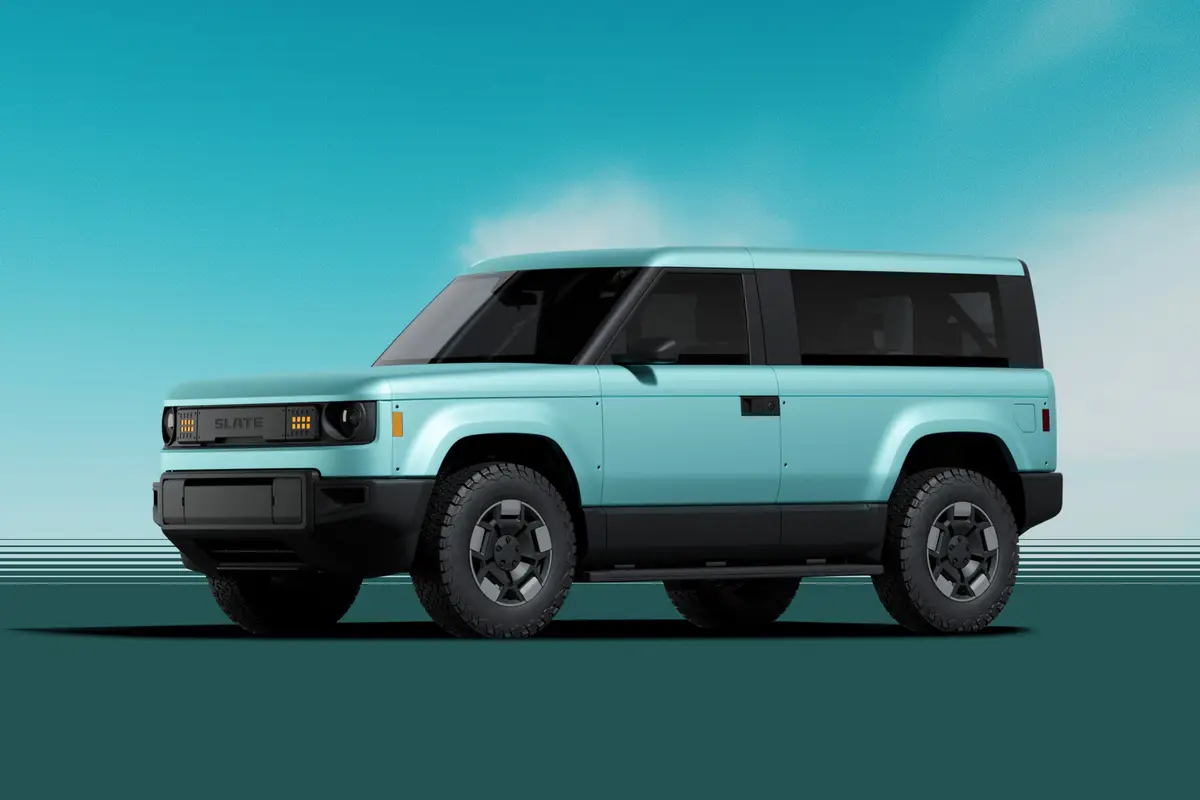There’s a Lot to Love (and Worry) About Slate


Slate, the previously self-labeled “worst kept secret” in the automotive industry, is the automotive buzz story of 2025. The headlines surrounding its eponymous Slate Truck dominate the conversation: a compact (maybe even subcompact), two-door, single-spec modular electric truck with a North American Charging Standard charge port, hand-crank windows and no stereo with a price tag “under $20,000” after federal EV tax rebates. The Slate Truck could be the next landmark car — or it could just as easily be yet another failed electric startup added to the pile.
Related: Slate Reveals Modular Electric Pickup Truck, SUV Priced Under $20,000 After Tax Credits
What defines a “landmark car”? Don’t bother Googlin’ — I made that label up. It’s a concept I’ve ruminated on awhile now. When I think of a landmark car, I consider cars that are inarguably definitive and revolutionary, a set of vehicles that created or sustain a new segment, significantly advance the industry, or are indelibly ingrained in our culture. It could represent one or all of these categories. In short, these are the greatest and most important cars in history, and in my opinion, there are less than you might believe. I’m not talking about good cars, or even great cars; I mean cars that have changed the course of the cultural and industrial landscape. Here are a few I consider landmark cars, in no particular order: Ford Model T, Mercedes-Benz Patent-Motorwagen, Volkswagen Beetle, Ford Mustang, Porsche 911, Tesla Model S, Willys MB, and the Toyota Corolla and Prius.
Those are some mighty big names to drop in an article discussing a startup automaker with not a single car produced, confirmed pricing or even the full technical picture. The Slate Truck is, however, already the most discussed, debated and anticipated vehicle I’ve seen since, well, the Ford Maverick. There’s a lot to unpack there.
How Is the Slate Truck So Affordable?
“The definition of what’s affordable is broken,” CEO Chris Barman said at the automaker’s packed debut in Long Beach, Calif. “Slate exists to put the power back in the hands of customers who have been ignored by the auto industry.” A claimed base price of under $20,000 is ostensibly how Slate returns the power to the people with the truck, so achieved via federal EV incentives and some clever product design, packaging and production streamlining that offers the customer a single choice: standard or big battery.
Everything else on the Slate Truck is monospec. A single rear-mounted 150-kilowatt electric motor returns 201 hp and 195 pounds-feet of torque via either a standard 52.7-kilowatt-hour battery or an optional 84.3-kWh battery; targeted range of the standard battery is around 150 miles, and it’s 240 miles for the bigger pack. Tesla-based NACS charging is standard, giving Slate drivers access to Tesla’s sprawling Supercharger network that should see the Slate Truck DC fast-charge rates returning 20%-80% charge state in roughly 30 minutes.
All trucks are delivered in the same shade of gunmetal gray, with the colored composite body panels eliminating the need for a paint workshop on the production line. Customers can add color to their truck via Slate’s seemingly expansive selection of precut vinyl wraps the automaker says can be installed for you or is easy enough to install by yourself. A do-it-yourself ethos and modularity is one of the truck’s biggest selling points; for example, separate flat-pack kits from Slate allow customers to turn their two-seat truck into a four-seat, closed-cabin SUV or four-seat, open-air recreation vehicle like a Jeep Wrangler.
The kits are purported to include airbags, seats, seat belts, rollbars and exterior shells. These are the most significant and presumably expensive accessories available in Slate’s long list of accoutrement available at launch, with others being bumpers, grille inserts, wraps, wheels, suspension lifts (or drops), and mounts for a JBL-style Bluetooth speaker, among others. Correct — speaker mounts, as no Slate will arrive with an integrated sound system. Nor will it have touchscreen-based infotainment, instead providing out-of-the-box mounting hardware for your phone or tablet that presumably will enable Apple CarPlay or Android Auto.
There are no power windows, either — just hand cranks. It’s an interesting choice considering the truck arrives with cruise control, power locks and forward collision mitigation. Then you realize power windows are to be a future accessory, and it all makes sense again. Taken from a thousand-foot view, what a revolutionary idea! A modular, (presumably) rugged electric truck that’s not only affordable, but is designed to evolve with you as your financial capability grows and your spatial needs expand.
At face value, this has all the trappings of The People’s Car 3.0, the modernist follow-up to the Model T and Beetle — both vehicles cited as “north star” inspirations for Slate, per a TechCrunch report.
I’m as skeptical as I am excited.

What About the Slate Truck’s Pricing and EV Charging?
Pricing is the greatest uncertainty. The federal EV tax incentive still exists as of this writing, but that could change within a matter of days, not months, in the current political climate. Moving past the discussion of whether a tax rebate equals a true, wholesale reduction in paid MSRP, this $7,500 credit means the on-paper starting price of the Slate Truck is between $25,000 and $27,500 — approximately $1,500 to $3,500 off a base, no-option 2025 Maverick at $28,590 (including destination).
For those looking for an affordable, efficient little trucklet with a new-car warranty, it’s hard to argue the Ford wouldn’t be the obvious choice against the Slate. Other than the inherent capability offered by the Maverick’s four-door, five seat configuration, the Ford arrives with power windows, a full active-safety suite, integrated sound system, infotainment, an established service network and a stronger standard towing capacity. They’re all things that I personally don’t believe can be categorized as “stuff we don’t want,” a sentiment repeated during Slate’s debut presentation as they rightfully railed against the automotive industry’s continued charge of putting all sorts of crap on cars that most consumers legitimately don’t need or want.
Without the full pricing breakdown, the price of the modular conversion packs could make this a nonstarter, too. The Slate Truck looks cool, but what if the SUV kit turns the (hypothetical) $26,000 truck into a $31,000 (or more) proposition? What if window switches, an SUV kit and a new wrap make this a $35,000 vehicle? For someone looking for basic, no-frills electric transportation, a base-level Chevrolet Equinox EV can be had for around $35,000 with more range and a more robust service network.
The presentation also made note that the majority of Americans make under $100,000 a year and presumably make up the majority of the nascent automaker’s targeted consumer base. It’s a fabulous sentiment, but I frankly don’t believe EV ownership presently makes much sense for that demographic. If you, as an individual or household, make under six figures and live in a major metropolitan area, you’re more than likely not in the financial position to purchase property. You likely live in an apartment and must charge your EV off-site. Ask me how I know.
No, you can’t just ask your landlord to install charging capability, and no, charging in EV-dense Los Angeles isn’t a breeze. Charging lines at Electrify America stations in Southern California are almost universally packed outside of midnight — again, speaking from regular experience. Access to Tesla charging stations might improve this, but plug competition with Teslas and other EVs gaining access to that network means EV ownership in a metropolitan area without a garage or driveway to charge in is annoying at best and untenable at worst.
This compounds when you move to regions outside of major California cities. Charging infrastructure is far less robust in rural and exurban areas, though you’re far more likely to be a homeowner the farther you move out of the city sprawl. Without strong and reliable regional charging, your Slate Truck is somewhat geofenced to your town. In both scenarios — if it’s a truck bed you need — a Maverick makes more sense.
Tariffs and manufacturing are another point of concern. Slate proudly claims the truck will be manufactured in a “reindustrialized” plant in Indiana — somewhere insiders have pegged near Indianapolis. While this partially circumnavigates the current administration’s ongoing tariffs and trade restrictions, it’s still not clear what and how many components are sourced from outside the U.S., something that could potentially affect pricing and the projected production start sometime in 2026.
More From Cars.com:
- Here Are the 10 Cheapest Pickup Trucks You Can Buy Right Now
- 2025 Cars.com Affordability Report: Best Value New Cars
- What to Know Before Purchasing an Electric Vehicle: A Buying Guide
- More EV News
Stirring Up Excitement
Clearly, it’s too early to levy a round judgment onto the success of Slate — but it’s not too early to get excited. For every internet detractor I found, there was a matching deposit holder who effused about how they can’t wait for the truck to carry their mountain bikes, haul mulch and serve as a dedicated beach buggy. A number of folks also mentioned the Slate’s potential as a first car for their teens, especially considering the Slate’s modularity and capacity for growing with the evolving needs of the owner.
And for all of my skepticism, why wouldn’t I be excited about an automaker turning its focus on affordability? The Slate is inherently an interesting product — particularly from an industrial design perspective — and the mere existence of simple, rugged automotive “tools” is ultimately a net positive. With its inherent capability for personalization, the Slate Truck also might prove a boon for small businesses looking for both promotion and utility in addition to potentially creating a wave of new enthusiasts whose DIY experience with the Slate Truck kindles newfound automotive passion.
Time will tell whether Slate is another historic automotive success story or just another shuttered EV startup. Regardless, it has folks mighty excited — and that’s an outright win in my book.
Related Video:
Cars.com’s Editorial department is your source for automotive news and reviews. In line with Cars.com’s long-standing ethics policy, editors and reviewers don’t accept gifts or free trips from automakers. The Editorial department is independent of Cars.com’s advertising, sales and sponsored content departments.

Conner Golden joined Cars.com in 2023 as an experienced writer and editor with almost a decade of content creation and management in the automotive and tech industries. He lives in the Los Angeles area.
Featured stories



